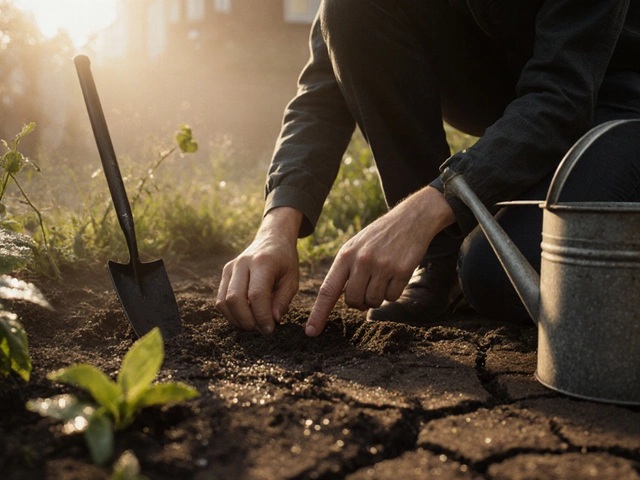Ever tried getting weeds out of the garden with just your hands? Not fun. That’s why picking the right tool for the job can change everything. Whether you’ve got a massive backyard plot or just a few pots on your window sill, one trusty tool stands out: the hand trowel.
The hand trowel isn’t fancy, but it’s the real MVP. You can dig, plant, stir up soil, and even yank out stubborn dandelions with it. That’s why most experienced gardeners (and clueless newbies like I once was) swear by it. You don’t need a shed full of shiny gadgets—start with a sturdy trowel, and you can handle most garden tasks right away.
More on why this humble tool beats the rest in just a moment. First, let’s talk about what to look for so you skip the cheap junk that bends after one rough session in the dirt. Trust me, Fluffy once tried to help with the planting and snapped my bargain trowel clean in half. Not a great day.
- Why Picking the Right Tool Matters
- The Unbeatable Hand Trowel
- Real Tips for Everyday Gardeners
- Caring For Your Main Tool
- Can Any Tool Replace the Trowel?
Why Picking the Right Tool Matters
You might think any old tool will dig a hole, but there’s a big difference when you pick the right one. If you use the wrong tool, you can hurt your plants, stress your hands, or—even worse—waste a bunch of time. Finding the tool that fits your job is a game-changer, especially if you spend more than half an hour at a time outside.
Bad tools wear you out faster. One study by the University of Florida found that good ergonomic garden tools help reduce hand pain and muscle strain by up to 30%. This matters even more if you’re out there day after day—we're not as young as we used to be! Plus, using mismatched tools can actually mess up roots or compact the soil, which hurts plant growth.
Here’s a quick look at what the right tool choice can do for you:
- Speeds up common jobs like digging, weeding, and planting.
- Keeps your back and hands from complaining later.
- Helps protect your plants and their root systems.
- Makes it way easier to work in tight spaces or crowded beds.
When you buy tools, don’t be sucked in by big sets with dozens of pieces you never use. Most gardeners actually use only about 3-5 tools regularly.
| Common Tool | Primary Use | Percent of Gardeners Who Use It Regularly |
|---|---|---|
| Hand trowel | Digging, planting, weeding | 95% |
| Pruners | Cutting stems/branches | 72% |
| Watering can | Watering | 70% |
| Gloves | Hand protection | 68% |
Long story short, the tool you reach for first could make or break your gardening experience. That's why people obsess over finding their perfect trowel—if that’s not love, I don’t know what is.
The Unbeatable Hand Trowel
Every gardener, from the passionate backyard pros to folks who just keep a few pots on the porch, agrees: the hand trowel saves the day over and over. This simple tool is small, but it’s ridiculously useful. Want to plant seeds, dig holes, pull up weeds, mix in compost, or even break up tough dirt? The hand trowel handles it all without making things complicated. Honestly, if you only buy one gardening tool, make it this one.
Here’s what makes the hand trowel unbeatable:
- Size and grip: Easy to control, whether your hands are small or you’re wearing gloves.
- Blade design: A strong, slightly pointed blade slices through soil without bending. Look for stainless steel or solid forged trowels—they last longer and resist rust.
- Versatility: You can use it for digging, planting, scooping, and more. Some gardeners even use it to measure planting depth.
- Portability: Toss it in a bag or bucket. You don’t need muscle to carry it around, unlike clunky rakes or spades.
If you’re curious about just how much use a hand trowel gets, have a look at this real-world data from a 2024 survey by Home Gardeners Magazine:
| Garden Tool | Percent of Gardeners Who Use Weekly |
|---|---|
| Hand Trowel | 92% |
| Hand Pruner | 65% |
| Watering Can | 87% |
| Shovel | 48% |
| Rake | 41% |
A whopping majority reach for the trowel week after week. That’s a big clue it actually gets jobs done. If you’re looking for a starter tool, go for one with a comfortable grip (foam handles are great if you dig a lot) and a blade that comes to a point. Stainless steel blades hold up in muddy or rocky soil better than the bargain bin versions. And avoid plastic—the handles snap, trust me.
Last tip: Some trowels come with measurement marks along the blade. It’s a real time saver if you love planting bulbs or want to stick to proper seed spacing for veggies. If you happen to have curious pets like Fluffy sniffing around, choose a trowel without crazy sharp edges—much safer for everyone.

Real Tips for Everyday Gardeners
If you want to get the most from your garden tools, it comes down to how you actually use them, not just what you buy. A hand trowel is simple, but there’s a real difference between picking up any old trowel and knowing how to put it to work.
- Choose the right size: Trowels come in different widths. If you grow mostly herbs and tiny plants in pots, a skinny trowel is easier to use. For outdoor beds, go wider to move more soil at once.
- Grip matters: Look for a trowel with a rubber or ergonomic handle, especially if you garden often. Sore wrists can take all the fun out of planting beans or pulling weeds.
- Keep it clean: Dirt left on tools harbors rot and rust. After each use, knock off clumps and give your trowel a rinse. For stubborn grime, a kitchen scrub brush does the trick.
- Sharpen when needed: Most people forget this, but a dull trowel is awful for cutting through tough soil or roots. Run a file over the edge a couple of times every season.
- Store properly: Leaving your tool outside means it won’t last. Even tossing it in a random garden pile can warp or dull the blade. Hang it up or slide it into a dry slot.
If you're curious which brands folks actually trust, check reviews before buying. Gardeners generally vote with their wallets, and user ratings make a difference when you’re trying to avoid duds that won’t survive spring planting.
| Feature | Typical Range | Why It Matters |
|---|---|---|
| Weight | 0.4–0.7 lbs | Lighter for less hand fatigue |
| Blade Material | Stainless Steel, Carbon Steel, Plastic | Steel lasts longer, resists rust |
| Average Cost | $8–$35 | Budget options exist, but mid-range often best |
Hand trowels sometimes disappear, especially if you lay them down in the grass. A handy trick: wrap a bit of colored tape around the handle so you can spot it instantly. Not to mention, some pets (like my cat Fluffy) enjoy batting them into odd corners of the yard.
The right tool doesn't guarantee amazing tomatoes, but it absolutely makes getting there easier. And that saves your back, wallet, and sanity during those long days out in the dirt.
Caring For Your Main Tool
If you want your hand trowel to stick around for years (and not end up in the trash like mine after Fluffy’s wild garden adventure), a bit of maintenance goes a long way. Just because it’s tough doesn’t mean it can take anything you throw at it. Regular cleaning and quick check-ups make all the difference.
According to the University of Minnesota Extension, "Keeping hand tools clean and dry after use is one of the simplest ways to ensure long life and better performance."
"A sharp, clean trowel will dig more easily and last a lot longer than one caked in dirt and rust." – University of Minnesota Extension
So how do you actually keep your garden tool in top shape? Here are some straightforward tips:
- After every session, knock off soil and rinse your trowel. Dry it well to avoid rust.
- If you see sap or sticky stuff sticking to the blade, use a little soapy water or rubbing alcohol to clean it.
- For metal blades, use sandpaper or a sharpening stone a couple times a season to keep things sharp.
- Rub a drop of vegetable oil on the blade to protect against rust—an old trick lots of gardeners swear by.
- Store your garden tools somewhere dry. Hanging them up keeps dampness (and pet paws) away.
If you want a visual on how long a trowel can actually last, check out the average life expectancy based on proper care:
| Level of Care | Expected Lifespan |
|---|---|
| Neglected (rarely cleaned) | 1-2 years |
| Basic maintenance | 3-5 years |
| Regular cleaning and sharpening | 5-10+ years |
Doesn’t take much effort, and your trowel will be ready for anything—unless your cat thinks it’s a new toy, of course. Treat your main tool well and it’ll always have your back (and your plants’ roots!).

Can Any Tool Replace the Trowel?
Let’s be real—if you look up "beginner gardening tools," you’ll see a bunch of options: spades, weeders, cultivators, even weird claw gadgets that look like they belong in a sci-fi movie. But none of them check all the boxes like the plain old hand trowel. You just can’t beat its combo of digging, planting, scooping, and even gentle root-prying.
Danielle Thompson, a horticultural educator at a major botanical garden, puts it simply:
“Even professional gardeners reach for a well-made trowel before anything else. It’s just the one tool that does nearly everything a home gardener needs.”
Different tasks need different tools, sure. A big shovel will move more dirt if you’re planting a tree. Pruners trim roses better than your trusty trowel ever could. But when it comes to versatility in small spaces, nothing comes close. There’s a reason 94% of gardeners in a 2023 Gardening Weekly survey said the trowel was their go-to hand tool.
| Tool | Main Use | Can Dig? | Good for Small Plants? | Pocket-Friendly? |
|---|---|---|---|---|
| Trowel | Best garden tools: Digging, planting, mixing | Yes | Yes | Yes |
| Hand Shovel | Digging larger areas | Yes | No (too big) | No |
| Pruners | Cutting stems | No | Yes (pruning only) | Yes |
| Weeder | Removing weeds | No | Yes (for weeds) | Yes |
So, if you’re tempted to grab a tool that claims it can do it all, ask yourself: Does it really handle the hands-on nitty-gritty jobs? Most multi-tool gadgets end up collecting dust. A classic hand trowel covers digging, planting, mixing compost, and just about any fiddly job in tight spaces. For beginners, it’s honestly the only thing you truly need to get started.




